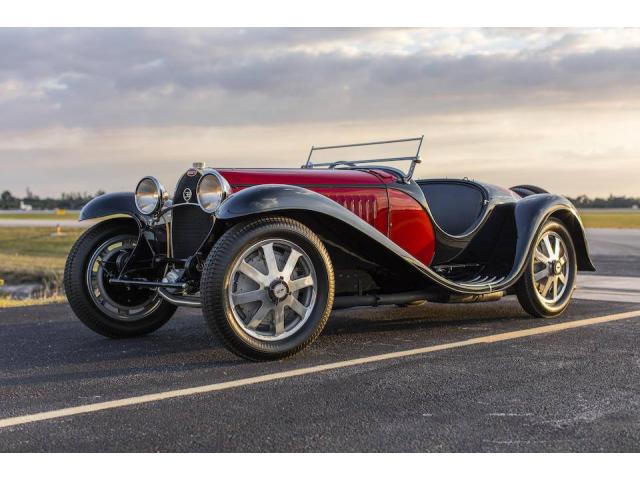1932 Bugatti Type 55 Super Sport Roadster Factory Coachwork by Jean Bugatti Design
- Brand: Bugatti
In the mid 1920s, the straight eight engined Bugatti Type 35 dominated motor racing by scoring literally thousands of victories. Simple, but very effective, the Type 35 was available with a number of engine displacements; either naturally aspirated or supercharged, making it eligible for almost every class. Capitalising on the motor racing success, Bugatti decided to launch a road going version of the racer in 1927. Dubbed the Type 43 Grand Sport, the road car featured a 2.3 litre Type 35B supercharged engine, installed in a lengthened and widened chassis to accommodate four passengers. Despite its high price the suitably named Grand Sport was quite successful with 160 cars being produced between 1927 and 1932.
By 1930 the competition had finally caught up with the small French racer, so it was time for a replacement for the ageing Type 35 and its derivatives. A new engine was designed to meet the increased demands, although it was very similar to two twin-cam Miller units Ettore Bugatti had acquired a few years earlier. After being showcased at the Paris Motor Show late in 1930, the Type 51 took to the track and picked up where the '35' had left off by racking up many wins. After the success of the Type 43, it was no surprise that a road going version of the new Grand Prix racer would again be produced. Announced late in 1931, the Type 55 'Super Sport' was similar in idea to the Type 43, but much different in execution.
While the four seater Type 43 was a big hit, Jean Bugatti's increasing influence persuaded his father Ettore to do something different for the Type 51 road car. The twin-cam engine was carried over from the new racing car, but fitted in a ladder frame chassis similar to the ones used for the sixteen cylinder Type 45/47 and the 4.9 litre Type 54 Grand Prix car. The chassis was slightly wider and a lot stronger, making it ideal for the road going Type 55. In good Bugatti tradition the chassis was suspended by solid axles and leaf springs. Slightly detuned for reliability reasons, the straight eight produced around 145 bhp. It was mated to the same four-speed gearbox used in the Type 43.
Jean Bugatti, just 22 years old at the time. added his magic touch by designing an absolutely stunning looking two-seater Roadster bodywork that has gone into history as one of the all time greats. Its lovely lines were further accentuated by a two-tone finish. The eight-spoke cast-aluminium wheels with integrated brake drums were directly lifted from the Type 51 and revealed the car's competition roots. In addition to the Roadster body, the Type 55 catalog also featured a Coupe design along similar lines. Most of these bodies were built by the factory with the exception of a few Roadsters that were constructed by Gangloff to relieve the work-load in Molsheim. With such a spectacular 'standard' design, it was not surprising that less than a handful were clothed by other coach-builders.
Even though the last one was not built until 1935, more than half of all Type 55s were constructed in 1932. Compared to the Type 43, the Type 55's production figure of just 38 examples might sound disappointing. However, considering it was a substantially different car and aimed at the richest of customers, the number constructed and sold is still relatively high, especially after the commercial failure of the Type 41 Royale. A true supercar in its era, the Type 55 Super Sport is still a highly desirable car thanks to its design and great driving characteristics.
Descriptions & pictures by ultimatecarpage & bonhams & other
| Specification | |
| Production Start | 1932 |
| Country of origin | Italy |


































